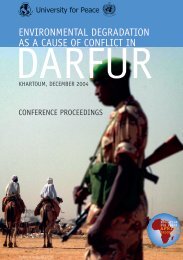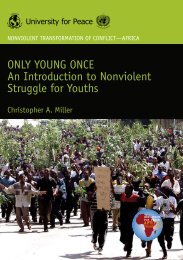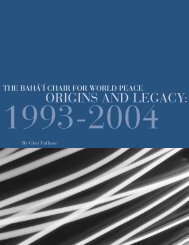who medicines strategy - libdoc.who.int - World Health Organization
who medicines strategy - libdoc.who.int - World Health Organization
who medicines strategy - libdoc.who.int - World Health Organization
You also want an ePaper? Increase the reach of your titles
YUMPU automatically turns print PDFs into web optimized ePapers that Google loves.
WHO MEDICINES STRATEGY 2004-2007 | 46Populations throughout the world use traditionalmedicine to help meet their primary healthcare needs. Traditional medicine b (TM), whichhas many positive features, is a comprehensiveterm that covers a wide variety of therapiesand practices — traditional, complementary oralternative medicine (TM/CAM) — which varygreatly from country to country and from regionto region. It plays an important role in treatingillnesses as well as improving the quality of lifeof those suffering from minor illness or fromcertain incurable diseases. In addition, globalexpenditure on TM/CAM is not only significantbut growing rapidly. 18Member States have difficulty assuring thesafety, efficacy, and quality of TM/CAM productsand therapies due to the lack of nationalpolicy frameworks, appropriate legislative andregulatory measures, and education/training andqualification schemes for practitioners.In 2002, in an effort to meet the growingchallenges in the area of traditional medicine,WHO developed a comprehensive working<strong>strategy</strong> for TM for 2002-2005. The Strategy hasfour main objectives:> To <strong>int</strong>egrate relevant TM and/or CAM withnational health care systems, as appropriate,by developing and implementing nationalpolicies and programmes.> To promote the safety, efficacy, and quality ofTM/CAM by expanding the knowledge baseon the safety, efficacy, and quality of TM/CAM,and by providing guidance on regulatory andquality assurance standards.> To increase the availability and affordabilityof TM/CAM, with an emphasis on access forpoor populations.> To promote the therapeutically sound use ofappropriate TM/CAM by both providers andconsumers.In May 2003, the 56 th <strong>World</strong> <strong>Health</strong> Assemblyadopted a resolution on TM, which urgesMember States, in accordance with establishednational legislation and mechanisms, to adapt,adopt, and implement the WHO TraditionalMedicines Strategy as a basis for nationaltraditional medicine programmes or work plans.It requests WHO to support Member States byproviding <strong>int</strong>ernationally acceptable guidelinesand technical standards, seeking evidence-based











